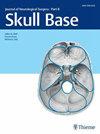Significant Underreporting of Preoperative Hyposmia in Patients Undergoing Endoscopic Skull Base Surgery: Discrepancies Between Subjective and Objective Measurements
IF 0.9
4区 医学
Q3 Medicine
引用次数: 0
Abstract
Abstract Objective The assessment of baseline olfactory function before endoscopic skull base surgery (ESBS) has been relatively limited compared with analysis before functional endoscopic sinus surgery (FESS). Our study addresses this knowledge gap, assessing preoperative olfactory function in ESBS and FESS and elucidating any differences. Study Design We conducted a retrospective review of patients undergoing anterior ESBS or FESS at a single institution between 2021 and 2022. We included 171 patients and compared their reported and measured preoperative olfactory function using the Sino-Nasal Outcome Test questionnaire and the 40-item University of Pennsylvania Smell Identification Test. Results Of the 171 patients included in this study, 30% of patients underwent ESBS and 70% underwent FESS. Of all patients, only 57% correctly reported their objective preoperative olfactory function. Of the 36 ESBS patients with measured preoperative hyposmia, only 31% correctly reported hyposmia, while 69% incorrectly reported normosmia. This distribution significantly differs (p < 0.0001) from the FESS subset (89 patients), with 64% correctly reporting hyposmia and 36% incorrectly reporting normosmia. Conclusions Our analysis demonstrates higher than anticipated underreporting of preoperative hyposmia in patients undergoing ESBS as well as discrepancies between subjective and objective olfactory functions in the FESS population. The results highlight several gaps in knowledge regarding perioperative olfactory function that would be best examined with more thorough pre- and postoperative objective olfactory testing. This analysis demonstrates significant prognostic uncertainty for patients and providers and creates significant medicolegal uncertainty regarding the appropriate attribution of postoperative olfactory loss in cases without objective preoperative testing.内镜下颅底手术患者术前低通气的显著漏报:主观和客观测量的差异
目的与功能性鼻窦内镜手术(FESS)前的分析相比,内镜颅底手术(ESBS)前的基线嗅觉功能评估相对有限。我们的研究解决了这一知识差距,评估了ESBS和FESS的术前嗅觉功能,并阐明了任何差异。研究设计我们对2021年至2022年间在一家机构接受前路ESBS或FESS的患者进行了回顾性研究。我们纳入了171例患者,并使用中国鼻结果测试问卷和40项宾夕法尼亚大学嗅觉识别测试来比较他们报告的和术前测量的嗅觉功能。结果171例患者中,30%的患者接受了ESBS, 70%的患者接受了FESS。在所有患者中,只有57%的人正确报告了他们术前的客观嗅觉功能。36例ESBS患者术前低氧测量中,只有31%正确报告低氧,而69%错误报告正常低氧。这种分布显著不同(p <0.0001)来自FESS亚组(89例患者),64%正确报告低血症,36%错误报告正常血症。结论:我们的分析表明,在接受ESBS的患者中,术前低氧的漏报率高于预期,FESS人群的主观和客观嗅觉功能也存在差异。结果突出了围手术期嗅觉功能知识的一些空白,最好通过更彻底的术前和术后客观嗅觉测试来检查。该分析表明,对于患者和提供者来说,预后存在很大的不确定性,并且在没有客观术前检测的情况下,对于术后嗅觉丧失的适当归因,在医学上也存在很大的不确定性。
本文章由计算机程序翻译,如有差异,请以英文原文为准。
求助全文
约1分钟内获得全文
求助全文
来源期刊

Journal of Neurological Surgery Part B: Skull Base
CLINICAL NEUROLOGY-SURGERY
CiteScore
2.20
自引率
0.00%
发文量
516
期刊介绍:
The Journal of Neurological Surgery Part B: Skull Base (JNLS B) is a major publication from the world''s leading publisher in neurosurgery. JNLS B currently serves as the official organ of several national and international neurosurgery and skull base societies.
JNLS B is a peer-reviewed journal publishing original research, review articles, and technical notes covering all aspects of neurological surgery. The focus of JNLS B includes microsurgery as well as the latest minimally invasive techniques, such as stereotactic-guided surgery, endoscopy, and endovascular procedures. JNLS B is devoted to the techniques and procedures of skull base surgery.
 求助内容:
求助内容: 应助结果提醒方式:
应助结果提醒方式:


